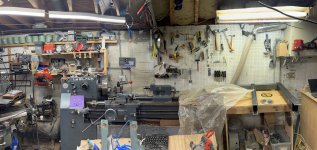jaguar36
Member
- Joined
- Jul 19, 2011
- Messages
- 288
I'm fedup with the layout of the storage on one wall of my shop. I've got got a couple shelves on one half that hold my cordless tools, drill bits, screws and stuff and then a pegboard on the other side that has some hand tools and random crap on it. I want to redo the wall and am debating if I should put up cabinets, or a french cleat system, or just more shelves or what. Cabinets would keep the dust out of everything which would be great, but then its harder to find stuff and takes longer to get it out. Definitely plan on ditching the peg board, its a very inefficient use of space and I've got a small shop so I need every bit.
I'd like something flexible as my tool/supplies are constantly changing. Right now I'm leaning towards cabinets on the ends with some shelves in the middle for the more commonly used items. Of course shelves aren't great as things get hidden in the back and it seems like it always just turns into a big pile of crap.
All of my Festool stuff is in drawers under the work bench so thats not an issue.
Anyone have a setup they really like? Pictures would be great!
I'd like something flexible as my tool/supplies are constantly changing. Right now I'm leaning towards cabinets on the ends with some shelves in the middle for the more commonly used items. Of course shelves aren't great as things get hidden in the back and it seems like it always just turns into a big pile of crap.
All of my Festool stuff is in drawers under the work bench so thats not an issue.
Anyone have a setup they really like? Pictures would be great!



![IMG20230927101726[1].jpg](/data/attachments/79/79438-fb5402293428ef393ab36efd7045c415.jpg?hash=9miNbFm-z0)